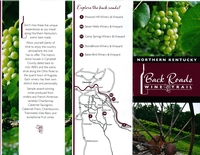Creators Syndicate
My recent column on "American Wine," the book (by Master of Wine Jancis Robinson and American wine journalist Linda Murphy) as well as the topic, struck a chord last week with one reader. John Bojanowski is a native of Kentucky who now lives in the south of France, making wine at Clos du Gravillas in St. Jean de Minervois.
Wrote John:
 "I’m delighted to see this book, as I respect what Jancis writes and am personally interested in the subject. I grew up in Kentucky and somehow ended up growing organic grapes and making wines (out of unloved varietals, most passionately) in St Jean de Minervois, Languedoc.
"I’m delighted to see this book, as I respect what Jancis writes and am personally interested in the subject. I grew up in Kentucky and somehow ended up growing organic grapes and making wines (out of unloved varietals, most passionately) in St Jean de Minervois, Languedoc.
"I’m back home in Kentucky a couple of times per year and have noted two things: The number of Kentucky wineries has gone from 5 to 50 in 10 years, and each time I go back, I buy four to five bottles, which inevitably finish in the sink.
"A firm believer that it is possible to make good wine ‘in most places and with most varietals,’ I look at Kentucky’s advantages (limestone) and think there might be application there for some of what I’ve learned over here in France (it don’t get no more limestonier than in St. Jean de Minervois …). I think there’s a philosophical muddle going on — the neo-growers are trying to ‘make to market’ rather than discovering ‘good practice’ to figure out how to make good taste under local conditions (and local good practice is much easier to find here than in Kentucky).
"Ever had a good Kentucky wine or even a drinkable one? I visited Jim Law at Linden in Virginia a few years ago, and he’s understood his vineyard constraints absolutely. So I know Kentucky is possible."
 I know next to nothing about Kentucky wine, but I would say to John that the growth spurt in the number of wineries over the past decade is encouraging. That would seem to indicate that there is an underlying belief in the potential of the region.
I know next to nothing about Kentucky wine, but I would say to John that the growth spurt in the number of wineries over the past decade is encouraging. That would seem to indicate that there is an underlying belief in the potential of the region.
There are many challenges in these non-traditional winegrowing regions, which is why so many aspiring vintners locate in California, where the conditions are just about ideal.
For example, Eastern wine regions such as Pennsylvania, New York, North Carolina, Virginia and Georgia often have a wet spring. That happens in California, but not very often.
Those areas also are prone to hail in the summer months, which is rare in California. Then there is the shorter growing season, which makes it tricky as harvest (and stormy weather) approaches as the leaves begin to turn.
 Yet in recent years we’ve seen glorious wines emerge, crafted by dedicated vintners who’ve figured out the climate and the soil and made the advances in technology and vineyard practices that were necessary to produce high-quality grapes. Perhaps Kentucky will be next, although to this point none of the wineries there have mustered the courage to compete on the world wine competition stage — at least, not that I am aware.
Yet in recent years we’ve seen glorious wines emerge, crafted by dedicated vintners who’ve figured out the climate and the soil and made the advances in technology and vineyard practices that were necessary to produce high-quality grapes. Perhaps Kentucky will be next, although to this point none of the wineries there have mustered the courage to compete on the world wine competition stage — at least, not that I am aware.
But I have no doubt that if there’s good wine being made in Georgia and Ohio and Michigan and Missouri and South Dakota and Colorado — and there is — then there’s hope for Kentucky, too.
8
